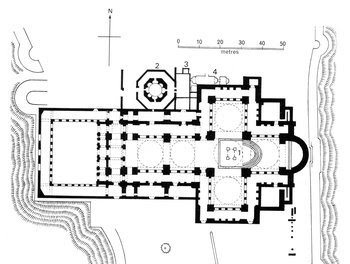
The following was taken from a longer account regarding my pilgrimage to the tomb of the Apostle John in 2001, which can be read here.
By John Sanidopoulos
Originally the Basilica of the Apostle John in Ephesus had been in a cruciform shape with six massive domes. More recently they have uncovered a baptistry and and a small chapel to the side. The tomb of the Apostle is today exposed to the elements, but originally it was located under the main central dome of the church [a model replica of the church can be seen below]. Unfortunately three relics which were still in the church during Ottoman times are now lost to us - a piece of the True Cross worn by the Apostle John around his neck, a garment of the Apostle made by the Theotokos, and most significantly for biblical scholarship today was the original manuscript of the Apocalypse which was authored by this apostle.
When the Apostle John was over one hundred years old, he took seven of his disciples, went outside the town of Ephesus and ordered them to dig a grave in the form of a Cross. After that, John went down into this grave and was buried. Later on, when the faithful opened John's grave, they did not find his body. Tradition holds that he, like the Virgin Mary, was among the first to be raised from the dead.

Each year for about a thousand years from the grave of the holy Apostle John on May 8th there came forth a fine ash-dust, which believers called "manna", and gathered it up after an all-night vigil and were healed of sicknesses by it. Therefore the Church celebrates the memory of the Apostle John the Theologian still on May 8 to commemorate this miracle, even though his main feast is on September 26.
Many pilgrims of medieval times make note of this extraordinary miracle. Both Augustine and Gregory of Tours make reference to this annual miracle. Anglo-Saxon Willibald, later a bishop and a Saint, visited Ephesus in 724 and marvelled at the miracle of the manna that bubbled from the tomb of the Apostle. Symeon Metaphrastes in the tenth century writes of the festival on May 8th being of such great magnitude that it seemed there were more people in attendance to take part in the miracle and receive a portion of its distribution than there were stars in the sky.

According to one author, the most elaborate description of the miracle dates to 1304 by Catalan Muntaner who arrived in a mercenary force:
"On Saint Stephen’s day, every year, at the hour of Vespers, there comes out of the tomb (which is four-cornered and stands at the foot of the altar and has a beautiful marble slab on the top, full twelve palms long and five broad) and in the middle of the slab there are nine very small holes, and out of these holes, as vespers are being sung on St. Stephen’s day (on which day the Vespers are of St. John), manna like sand comes out of each hole and rises a full palm high from the slab, as a jet of water rises up. And this manna issues out . . . and it lasts all night and then all Saint John’s day until sunset. There is so much of this manna, by the time the sun has set and it has ceased to issue out, that, altogether, there are of it full three cuarteras of Barcelona [about 120 quarts]. And this manna is marvelously good for many things; for instance he who drinks it when he feels fever coming on will never have fever again. Also, if a lady is in travail and cannot bring forth, if she drinks it with water or with wine, she will be delivered at once. And again, if there is a storm at sea and some of the manna is thrown in the sea three times in the name of the Holy Trinity and Our Lady Saint Mary and the Blessed Saint John the Evangelist, at once the storm ceases. And again, he who suffers from gall stones, and drinks it in the said names, recovers at once. And some of this manna is given to all pilgrims who come there; but it only appears once a year."
